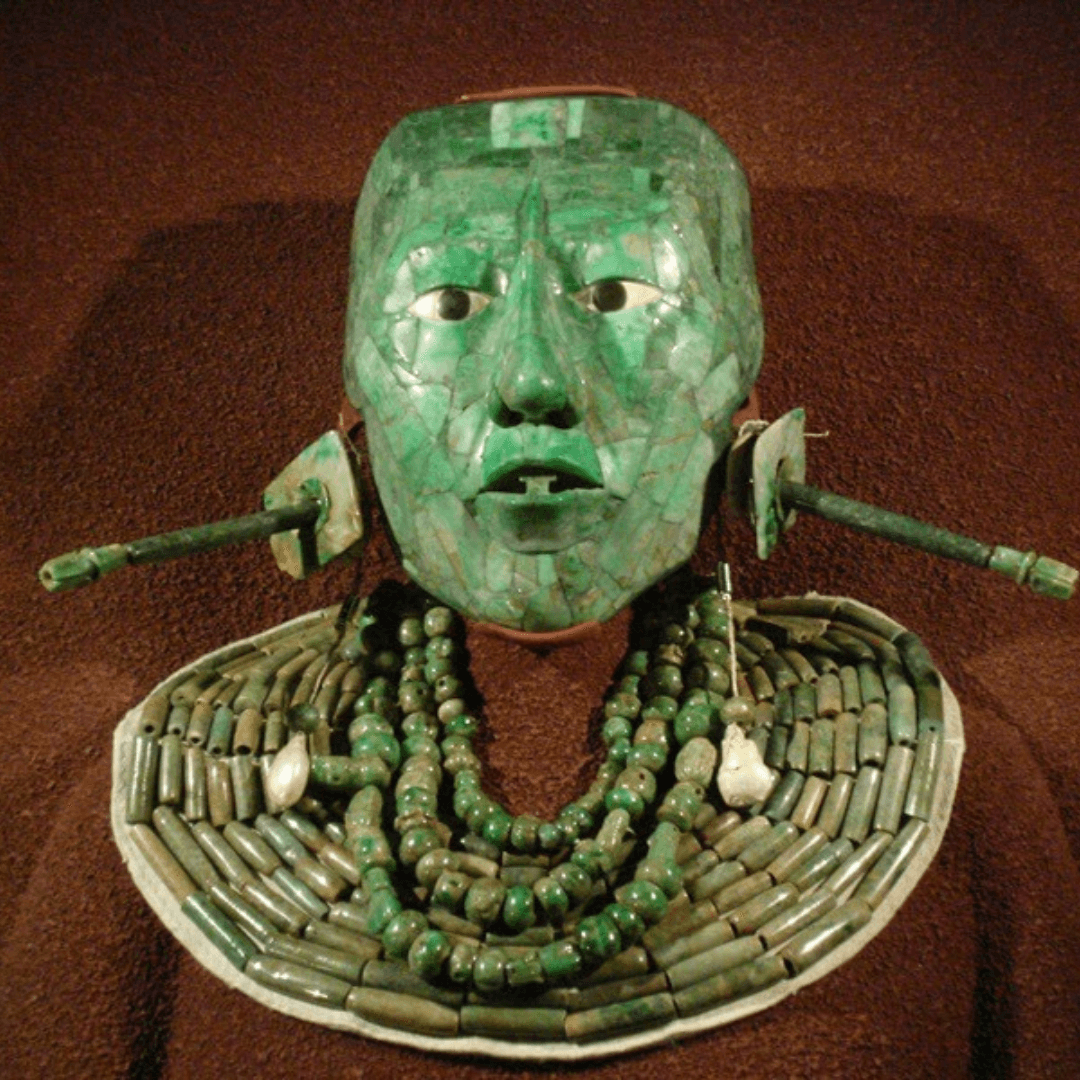Helen Serras-Herman - 12/2/2016
The sources for Mesoamerican jade were lost for the past five centuries, until the search began in the mid twentieth century. Ancient jade artifacts had been discovered earlier at archeological sites, but no jade was found in situ until 1952.
Jade was revered in the Maya world, an ancient culture that flourished in the first millennium A.D. in Mexico and Central America. The Maya civilization stretched geographically over what is known today as Guatemala, Belize, southern Mexico, and the western regions of Honduras and El Salvador. The Maya excelled in architecture, astronomy, mathematics, agriculture and the arts.
The Maya, just as their predecessors, the Olmecs, held jade in the highest esteem, as it was rare and valuable, and represented eternity. They buried their kings adorned with jade masks and pectorals, considering jade the ultimate passport to the afterlife. For the Maya, green represented the life-giving water of the Sacred Cenotes (natural wells) and the rare green quetzal bird feathers, and green symbolized the crops and fertility.
Besides the burial masks, jade was carved into rings, ear flares, pendants, beads and ceremonial objects. In addition to the colors, jade was valued — and still is today — for its durability and its ability to take a high polish.
Stretching back to 1800 B.C., the Maya civilization is famous for its Classic Period (the pinnacle of jade carving production), dating between A.D. 250 and 900. After that date, the downfall of the classic Maya began, and most cities were eventually abandoned, with the exception of the cities in the northern Yucatán Peninsula, where the Maya people retreated, until it all came to a violent end with the invasion of the Spaniards in 1517.
At the beginning of the Spanish conquest, the Maya people kept the location of their jade mines secret in order to protect them from the invaders, who thankfully did not value jade. But over time, the location of the ancient mines and quarries became forgotten and lost.
The Maya Jade rediscovery story
The amazing story of the jade rediscovery spans over a century, involving many American scientists and rockhounds enamored with jade.
American geologist William Foshag, curator of the Department of Mineral Studies of the National Museum of Natural History (Smithsonian), had spent several years in Mexico and Guatemala in the 1940’s studying the ancient jades and the geology of the area. Foshag wrote about the discovery of jade in 1952 in the Motagua River Valley of Guatemala by fellow American Robert Leslie (Foshag, 1955).
In Foshag’s book, Mineralogical studies on Guatemala Jade, published a year after his death (Foshag, 1957), it is detailed about how his research used x-ray diffraction patterns and refractive indices to categorize the Guatemalan jade as jadeite, and found it to be similar to jade found in Burma. This was the beginning of the rediscovery of the Maya jade mining sources.
But it wasn’t until another American couple, archaeologist and anthropologist Mary Lou Ridinger and her late husband Jay Ridinger, actually searched for the jade and found their first outcrop of green jade on a tributary of the Motagua River in 1974. They sent samples to the GIA (Gemological Institute of America) and other labs, all of which confirmed their finds as jade.
Jade Minerals
Jade is a generic term that describes several gem materials.
Nephrite, Ca2(Mg, Fe)5Si8O22(OH)2, is a massive rock consisting of felted, intergrown, fiberlike crystals of the minerals tremolite and actinolite, members of the amphibole family of minerals (Harlow, 1993). Nephrite is found in many places in the world including China, British Columbia, Siberia, New Zealand, and Wyoming, USA, and occurs in many colors ranging from pure white to green to black.
Jadeite, NaAlSi2O6 , the jade used by the ancient Maya, is a rock composed mostly of the pyroxene mineral jadeite, known mineralogically as jadeite rock or jadeitite (Harlow, 1993).The only other major source of jadeite in the world is Myanmar (Burma), where the famous translucent green ‘imperial jade’ comes from; there are also new sources found in Cuba and the Dominican Republic.
Omphasite jade, CaMgSi206, is a pyroxene that is roughly half jadeite and half diopside, and it is the latest jade variety to be included in the international approved jade nomenclature in Hong Kong. (Ogden, 2013)
The English term jade is derived from the Spanish piedra de ijada or yjada (=flank, side, hence loin stone or colic stone) as it was supposed to cure kidney ailments. Latin scholars in sixteenth-century Europe coined the term Lapis nephriticus, which later became nephrite.
Jadeite was identified as a separate mineral from nephrite, by French professor A. Damour in 1864, whose chemical analysis in 1881 proved that the Mexican stone was also jadeite. So, ironically, after all those years, the Spaniards’ “piedra de yjada” came to be known as jadeite.
Guatemalan jade today
A magnificent variety of jadeite colors is now mined in Guatemala. Jadeite in every shade of green is collected there, as well as white, creamy yellow, blue, and my favorite, the rare lavender, discovered in 1998. Jade boulders of different colors can be found side-by-side in the field, even boulders with various colors within. Among the green varieties are the rare “Maya imperial jade” — the bright emerald-green variety, and the “Mayan foliage” — a very popular green-and-white mottled variety. All of their jade material is natural, not treated by dye or heat or bleach.
The jade’s physical appearance is granular, with a greasy luster. Its hardness is about 7 on the Mohs scale. The refractive index (RI) is 1.65-1.67 and specific gravity 3.20-3.34.
Also discovered is a scarce variety of fine-grained deep black jade that has flecks of precious metals — silver, nickel, cadmium, platinum and gold, as well as cubic golden pyrite inclusions, and was given the very appropriate name “Galactic Gold.” During the 2013 Tucson gem shows, I donated a slab to Gem-A, and a Raman spectrum test proved the material to be omphacite jade. (Ogden, Gems & Jewellery, March 2013).
While in Antigua, Guatemala, my husband and I visited the Jade Maya™ shop, the Ridingers’ gallery and factory for carving jade. It is a true luxury art gallery, where exquisite jade carvings are offered for sale.
Fabulous collections of jade artifacts, which we had the opportunity to visit in 2011 and 2012, are housed in museums across Mexico, Guatemala, and in Copan, Honduras. In the National Museum of Anthropology in Mexico City, we viewed the famous and most impressive jade mask and pectoral of King K’inich Janaab’ Pakal I, or King Pakal the Great (AD 683) of Palenque. At the Museum of Archeology & Ethnography in Guatemala City, Guatemala, we were astounded with the incredible imperial green jade collection of artifacts and jewelry, as well as the famous mask from Tikal.
Working with Guatemalan jade
Over the years I have carved most gem materials, including quartzes, aquamarines, beryls, turquoise and sapphires, but jade had never been on my palette, until I began working with the Guatemalan jade. My favorite Guatemalan jade variety is the lavender jadeite. I like its grainy look and rarity. It is easy to carve following standard lapidary steps. After sanding the carvings up to the 14,000 grit step, I achieved a good final polish with chromium oxide.
While carving the Guatemalan jade with my contemporary diamond tools, my thoughts went to how long did it take my fellow ancient Maya lapidaries to carve their magnificent pieces? After fashioning and drilling a few beads, I am in awe at the length of the holes of the ancient Maya jade beads — many between two and three inches. The ancient lapidaries used a wooden bow drill with a bamboo shaft and crushed garnet or jade abrasive.
My lavender jade carvings, though, proved to be more difficult to design around and incorporate into jewelry. I tried various gem materials, especially natural turquoise, but when paired with the lavender jade, they would overpower the pale lavender color. After much thought, I decided to stay in a pastel palette, using tanzanite-faceted beads, purple star sapphires, sugarcane emeralds from Brazil, and natural-color baroque-shaped freshwater cultured pearls, whose soft color variations from cream to gold to pinkish-white allowed the lavender jadeite to stand out.
Carving the black “galactic gold” jade was as dirty as any other gem material that has pyrite inclusions. The black residue color stains everything — from pans to fingernails. However, the black jade was easy to carve, sand and polish, with striking results.
I am truly grateful for the friends who motivated me to appreciate the Guatemalan jade: the late appraiser Mrs. Anna Miller, celebrated photographer and author Fred Ward, and Mary Lou Ridinger, who generously offered me her time and knowledge.
These friendships, the travels, the archeological sites and the fascinating history of the ancient Maya world, the ancient artifacts, together with the passion for gem knowledge and the pursuit of new materials stimulated the inspiration for my latest artwork, the Maya Jade Collection.
Helen Serras-Herman is an acclaimed gem sculptor with over 33 years of experience in unique gem sculpture and jewelry art. Her award-winning artwork has been exhibited world-wide and published in over 160 trade magazines and books. See her work at www.gemartcenter.com and her business Facebook page at Gem Art Center/Helen Serras-Herman.




